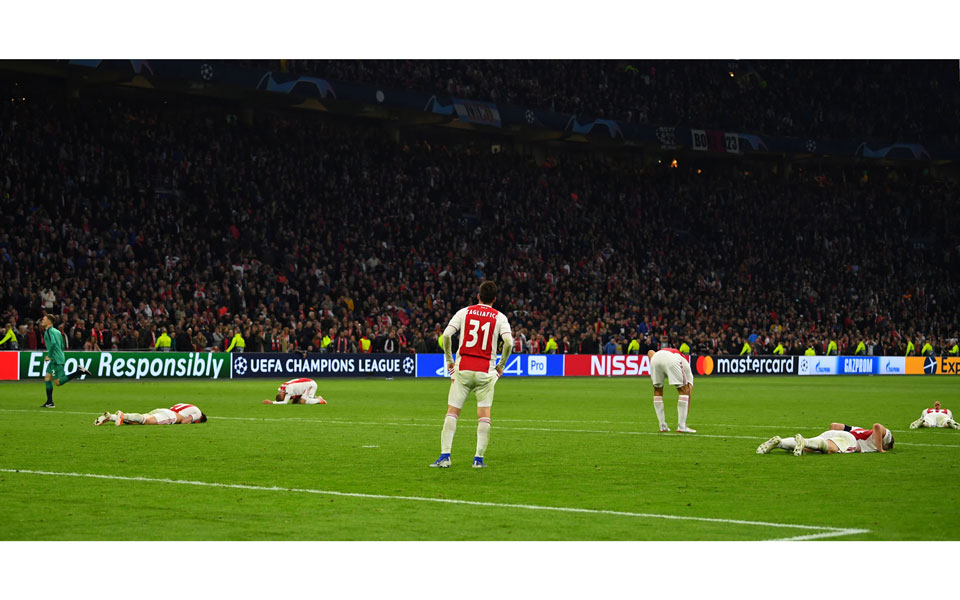Peeling the orange

If you’re lucky enough to fly to Amsterdam on a cloudless day, your gaze will inevitably be drawn to the unusually geometrical, handmade mosaic that is the Dutch countryside. Endless stretches of rectangular fields are demarcated by a dense network of drainage ditches and roads. Space has never been in abundance here. The Dutch have never had the luxury of wasting the tiniest bit of land. About a quarter of The Netherlands famously lies below sea level. Hard work, inventiveness and team spirit were required of the people if they wanted to keep their feet dry.
This spatial singularity is often considered as the origin of the consensus-based decisionmaking process of the Dutch, known as the “polder model.” In his book, “Brilliant Orange: The Neurotic Genius of Dutch Football,” which was recently made available in Greek (Diavlos), the English author and journalist David Winner argues that this very condition was at the root of what locals call “totaalvoetbal.”
Developed by manager Rinus Michels and spearheaded by Johan Cruyff in the late 1960s and early 70s, Total Football was a ground-breaking system based on speed, stamina, technical skill and intelligent use of space. “Total Football was, among other things, a conceptual revolution based on the idea that the size of any football field was flexible and could be altered by a team playing on it,” Winner writes. “In possession, Ajax – and later the Dutch national team – aimed to make the pitch as large as possible, spreading play to the wings and seeing every run and movement as a way to increase and exploit the available space. When they lost the ball, the same thinking and techniques were used to destroy the space of their opponents.”
The game had to be effectual but, most importantly, it had to be beautiful. Cruyff, who transformed Ajax and later Barcelona both as a player and manager, has often been likened to Rembrandt, Vermeer and other Dutch masters. Fascinated by his elegant, ballet-like stride, Rudolf Nureyev always said Cruyff should have been a dancer. Former Arsenal striker Dennis Bergkamp, one of the most technically gifted players to grace the Premier League (ex-Newcastle defender Nikos Dabizas probably still has nightmares of the Dutchman’s pirouette goal 17 years ago), was often criticized of lacking that killer instinct. “I suppose I’m not that interested in scoring ugly goals,” Bergkamp quipped – a statement that sums up “totaalvoetbal” philosophy yet is, at the same time, a very Dutch way of disguising weakness as moral superiority.
Winner’s writing is reminiscent of the system’s architecture. The author jumps back and forth from history to social change to the arts and to architecture, enriching the theory with interviews with ex-players and managers, as well as anecdotal passages. The only steady reference is Cruyff, the talisman of the Total Football revolution (sportswriter David Miller famously described him as “Pythagoras in boots”) whose unconventional personality and ideas shaped modern football as well as the personality of a nation.
In his effort to develop an attractive, holistic theory, Winner appears a bit too tempted at times to discover meaning and symbolism – like when he draws parallels between former Feyenoord midfielder Wim van Hanegem and the curved arched structures of Rotterdam architect Lars Spuybroek.
For the Dutch, of course, Total Football never really brought total success. In several crunch moments, the squad has appeared to come out onto the pitch with a self-destruct button. In the 1974 World Cup final in Munich, a combination of overconfidence and arrogance led to defeat against an inferior West Germany. After scoring the opening goal, the Dutch players began to mock their opponents with fancy footwork instead of finishing them off with a second goal – hubris of sorts. “There is still deep, unresolved trauma about 1974. It’s a very living pain, like an unpunished crime,” a Dutch psychoanalyst says in the book.
When the Oranje reached a third World Cup final in 2010 sacrificing the virtues of “totaalvoetbal” on the altar of a pragmatic, often cynical, style (the stamp of Nigel de Jong’s studs on Xabi Alonso’s chest was the painful souvenir from the Johannesburg final) the custodians of Total Football reacted to the ultimate fall of the Dutch side with a sense of self-righteous vindication. In their eyes, the Spanish tiki-taka of close-touch possession play was a more faithful reincarnation of Cruyff’s legacy.
As the young players with the iconic vertical red stripes upped the pressure on the Juventus defense inside the Johan Cruyff Arena in the first quarter final of the Champions League last month, the English sportscaster could not hide his admiration for their unique ability to create a pitch within a pitch: “It’s like Cruyff is still here,” he said. A few weeks later, what would have been an all-Cruyff Ajax vs Barcelona final would turn into a total nightmare for both clubs.





